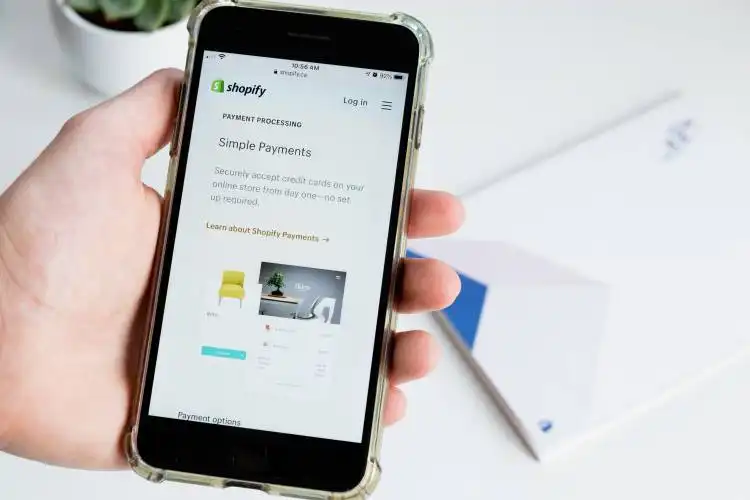Start a Marketplace Website Business
Creating Your Own Digital Bazaar: The Magic of Marketplace Websites
| Updated


MARKETPLACE WEBSITE BUSINESS
Imagine a bustling digital bazaar right at your fingertips - welcome to the wonderful world of marketplace website businesses! Such a business essentially serves as a virtual middle-man, connecting producers and consumers from all over the globe. Whether it's artisanal cheese, vintage furniture, or freelance graphic design services, your platform could become the go-to spot for niche enthusiasts. As an entrepreneur, developing a marketplace website allows you to pocket a percentage of every transaction - without the heavy lifting of making the items yourself!
Jump to Business Plan
RELATED BUSINESS IDEAS
Browse ALL Internet & Technology Startups Business Ideas
Discover Your Perfect Domain
Unlock the door to your online success with our hand-picked selection of premium domain names. Whether you're starting a new venture or rebranding an existing one, the right domain can set the tone for your digital presence. Browse through our curated list, each with its unique potential to enhance your brand's visibility and credibility.
MARKETPLACE WEBSITE MINI BUSINESS PLAN
This a quick reality check to help you identify the strengths and weaknesses of your business concept before you dive in.
Expected Percent Margins:
- Gross Margin: 10-30%
- Net Margin: 5-10%
Expected Earnings:
- Daily Revenue: $100 - $500
- Weekly Revenue: $700 - $3500
- Monthly Revenue: $3000 - $15000
- Annual Revenue: $36000 - $180000
Actions to Achieve These Numbers:
Platform Development:
- Initial Investment: Around $5000 - $20000 for a professional, reliable, and user-friendly platform.
- Maintenance: Regular monthly maintenance and updates.
Marketing & User Acquisition:
- Digital Marketing: Engage in Search Engine Optimization and Pay-Per-Click Campaigns. Almost $1000-$2000 per month needs to be invested.
- Social Media: Regular posts and interaction with potential customers on platforms popular with your target demographic.
Vendor Management:
- Vendor Acquisition: Establish relationships with diverse, trusted vendors. Be active on platforms like LinkedIn to initiate contact.
- Vendor Retention: Regular communications, prompt dispute resolutions and competitive commission rates.
User Experience:
- Customer Support: Maintain a 24/7 support team. This can be achieved through hiring staff or outsourcing to a Business Process Outsourcing (BPO) company.
- User-Friendly Interface: Regularly update the site for an optimal user experience.
Revenue Streams:
- Commission: Aim for a commission of 5-15% on each transaction.
- Advertisement Revenue: Aim to earn revenue from ads once a significant user base is established.
Please note these numbers are highly generalized and depend on multiple factors such as geographic location, state of the market, and specific business strategies. For more suitable estimations, get in touch with a financial advisor or business consultant.
NOT WHAT YOU HAD IN MIND? Here are more ideas



Browse ALL Internet & Technology Startups Business Ideas
Grab Your Business Website Name
Before you get caught up in the whirlwind of setting up your business, invest in a domain name. It's a small but significant step that lays the foundation for your brand and makes it easier for customers to find and trust you. Just like you wouldn't build a house without securing the land first, don't build a business without securing your domain name.
"Why? Can't that wait?" Here's why it shouldn't
Step 1: Determine if the Business is Right for You
Breakdown of Startup Expenses
Before starting a marketplace website business, it’s important to understand the startup costs associated with the endeavor. This includes the cost of registering a domain name, hosting fees, website design and development, and any other costs associated with setting up the website. Additionally, it’s important to consider the cost of any software or plugins needed to run the website, such as payment processing software and inventory management software. Finally, it’s important to consider the cost of any advertising or marketing needed to promote the website.
Breakdown of Ongoing Expenses
In addition to startup costs, it’s important to consider the ongoing expenses associated with running a marketplace website business. This includes the cost of hosting fees, website maintenance, and any other costs associated with keeping the website running. Additionally, it’s important to consider the cost of any software or plugins needed to keep the website running, such as payment processing software and inventory management software. Finally, it’s important to consider the cost of any advertising or marketing needed to keep the website visible.
Examples of Ways to Make Money
Once the website is up and running, it’s important to consider the various ways to make money. This includes selling products or services directly on the website, as well as any affiliate programs or advertising networks that might be available. Additionally, it’s important to consider any subscription services or membership programs that might be available. Finally, it’s important to consider any other opportunities to monetize the website, such as offering consulting services or creating a blog.
Step 2: Name the Business
Choosing the right name for your marketplace business is an important step. It should be memorable, easy to spell and pronounce, and should reflect the type of business you are running. Consider using a name that is related to the products or services you are selling, or that describes the type of marketplace you are creating. Additionally, it is important to make sure that the name you choose is not already taken by another business. You can search online to make sure that the name you have chosen is not already in use.
You may also want to consider registering the name as a trademark. This will help to protect your business and ensure that no one else can use the same name. Additionally, registering the name as a trademark will make it easier to market your business and create a recognizable brand.
Finally, you will need to check with the local government to make sure that the name you have chosen is available to use. This will help to ensure that you are not infringing on any existing trademarks or business names.
Step 3: Create a Business Plan
Creating a business plan is a crucial step in starting a marketplace website business. It should include a detailed description of the business, the products or services offered, the target market, the competitive landscape, and the financial projections. It should also include a marketing plan, which should include strategies for online and offline marketing, as well as a plan for customer acquisition and retention. Additionally, a business plan should include a risk assessment, which should identify potential risks and how to mitigate them.
Benefits of Having a Business Plan
Having a business plan is important for any business, but it is especially important for a marketplace website business. A business plan will help to ensure that the business is well-thought-out and that all aspects of the business are taken into consideration. It will also help to ensure that the business is financially viable and that the business will be able to meet its financial goals. Additionally, a business plan can be used to secure funding from investors or lenders. Finally, a business plan can help to ensure that the business is well-organized and that it is on track to reach its goals.
Step 4: Secure Financing
When starting a marketplace website business, it is important to secure financing for the venture. There are a few different sources of financing that entrepreneurs should consider. First, entrepreneurs can look to their own savings to fund the business. This is a great option for those who have the resources to do so. Additionally, entrepreneurs can look to family and friends for financing. This can be a great way to get the business off the ground without taking on too much risk. Finally, entrepreneurs can look to venture capitalists and angel investors for financing. This is a great option for those who are looking to scale quickly and need the capital to do so.
Consider a Loan
In addition to the sources of financing mentioned above, entrepreneurs should also consider taking out a loan. This can be a great way to get the capital needed to start the business. There are a few different types of loans that entrepreneurs should consider. First, entrepreneurs can look to traditional bank loans. This is a great option for those who have a good credit score and are looking for a low-interest loan. Additionally, entrepreneurs can look to online lenders. This is a great option for those who need quick access to capital and don’t have the best credit score. Finally, entrepreneurs can look to government-backed loans. This is a great option for those who are looking for a low-interest loan with flexible repayment terms.
Consider Crowdfunding
Finally, entrepreneurs should consider crowdfunding as a source of financing. This is a great option for those who are looking to raise capital quickly and don’t have the resources to do so. There are a few different types of crowdfunding that entrepreneurs should consider. First, entrepreneurs can look to reward-based crowdfunding. This is a great option for those who are looking to raise capital in exchange for rewards. Additionally, entrepreneurs can look to equity crowdfunding. This is a great option for those who are looking to raise capital in exchange for equity in the company. Finally, entrepreneurs can look to donation-based crowdfunding. This is a great option for those who are looking to raise capital in exchange for donations.
Step 5: Register the Business
In order to register the business, you will need to decide on a business structure and register with the appropriate government agency. Depending on the type of business you are starting, you may need to register with the IRS, the state, or both. Additionally, you may need to obtain a business license or permits from the local government. It is important to research the specific requirements for your business and make sure you are in compliance.
Choosing a Business Structure
When registering your business, you will need to decide on a business structure. The most common types of business structures are sole proprietorship, partnership, limited liability company (LLC), and corporation. Each structure has its own advantages and disadvantages, so it is important to research each one and decide which is best for your business. Additionally, you may need to consult with an attorney or accountant to make sure you are making the right decision.
Registering with the Government
Once you have decided on a business structure, you will need to register with the appropriate government agency. This will involve filing the necessary paperwork, paying the required fees, and obtaining any necessary licenses or permits. Depending on the type of business you are starting, you may need to register with the IRS, the state, or both. Additionally, you may need to obtain a business license or permits from the local government.
Benefits of Registering the Business
Registering your business has several benefits. First, it will give you legal protection from any liabilities or debts incurred by the business. Additionally, it will help you establish credibility with potential customers and suppliers. Finally, it will make it easier for you to open a business bank account and apply for business loans.
Step 6: Create the Website
Creating an effective website is essential for any business, especially a marketplace website business. It is important to make sure that the website is user-friendly, visually appealing, and secure. Additionally, it should be optimized for search engine optimization (SEO) so that customers can easily find it. To create an effective website, it is important to use a reliable web hosting service and a content management system (CMS) such as WordPress. Additionally, it is important to have a good domain name that is easy to remember and relevant to the business. Furthermore, the website should include features such as a shopping cart, payment gateway, and customer support system.
Tips for Developing the Website
Once the website is created, it is important to develop it further. This includes adding content, images, and videos to the website. Additionally, it is important to add features such as a blog, forum, and social media integration. Furthermore, it is important to make sure that the website is optimized for mobile devices and that it is secure. Additionally, it is important to make sure that the website is regularly updated with new content and features. Finally, it is important to make sure that the website is tested regularly to ensure that it is functioning properly.
Step 7: Market the Business
One way to market the business is through social media. Creating a presence on popular platforms like Facebook, Twitter, and Instagram can help to spread the word about the business. Additionally, creating a blog or website and utilizing SEO techniques can help to increase visibility. Paid advertising, such as Google Ads, can also be used to reach a larger audience.
Tips for Marketing the Business
When marketing the business, it is important to focus on the target audience. Knowing who the target customer is and what they are looking for can help to create more effective marketing campaigns. Additionally, it is important to create content that is engaging and informative. This can help to draw more attention to the business and encourage people to visit the marketplace website. Finally, it is important to track the success of marketing campaigns and adjust them accordingly. This can help to ensure that the business is reaching the right people and getting the most out of its marketing efforts.
Step 8: Monitor the Business
Monitoring the business is an important step to ensure that the marketplace website business is running smoothly. It is important to keep track of the performance of the website, the customer feedback, and the financials. Here are some tips for monitoring the business:
Track website performance: It is important to track the performance of the website, such as the number of visitors, page views, and conversions. This will help to identify any issues that may be affecting the performance of the website.
Monitor customer feedback: It is important to monitor customer feedback, such as reviews and ratings. This will help to identify any issues that customers may be having with the website.
Track financials: It is important to track the financials of the business, such as revenue, expenses, and profits. This will help to identify any areas where the business can improve its profitability.
Analyze data: It is important to analyze the data collected from the website, such as user behavior and website performance. This will help to identify any areas where the website can be improved.
Monitor competitors: It is important to monitor the competition, such as their website performance, customer feedback, and financials. This will help to identify any areas where the business can improve its performance.
Step 9: Grow the Business
Once the marketplace website business is up and running, it is important to continue to grow the business. There are many ways to do this, including advertising, expanding the product offerings, and providing excellent customer service. Advertising can be done through various methods, such as social media, search engine optimization, and email campaigns. Expanding the product offerings can be done by adding new products or services, or by partnering with other businesses. Finally, providing excellent customer service is an important way to ensure customer satisfaction and loyalty.
Tips for Growing the Business
When it comes to growing the business, it is important to focus on the customer experience. This includes providing helpful customer service, responding quickly to customer inquiries, and offering discounts or promotions. Additionally, it is important to keep up with industry trends and to stay ahead of the competition. Finally, it is important to measure the success of the business by tracking key performance indicators such as customer satisfaction and revenue.
EXPLORE MORE CATEGORIES
Browse ALL Business Idea Categories
TAKE THE NEXT STEPS










